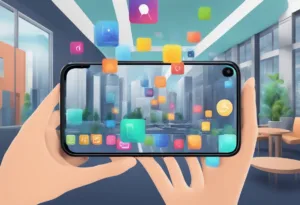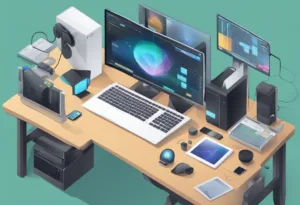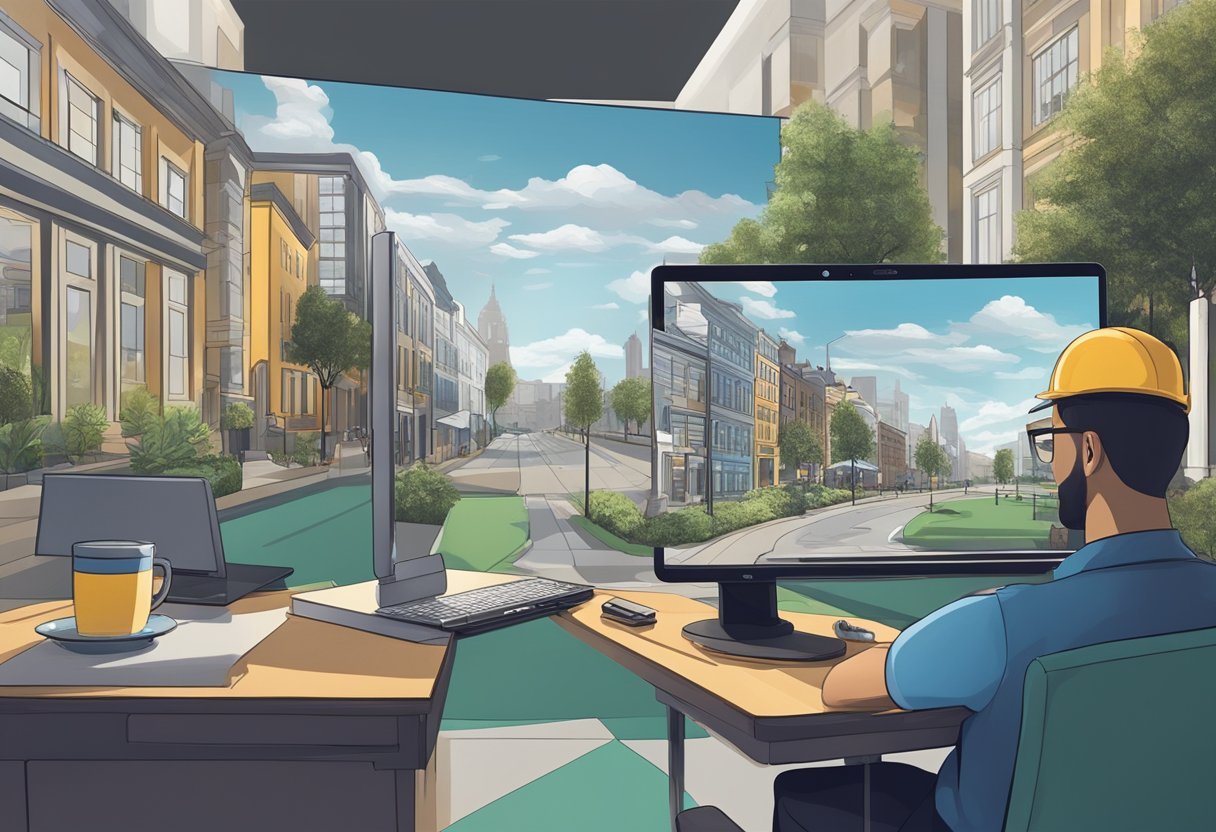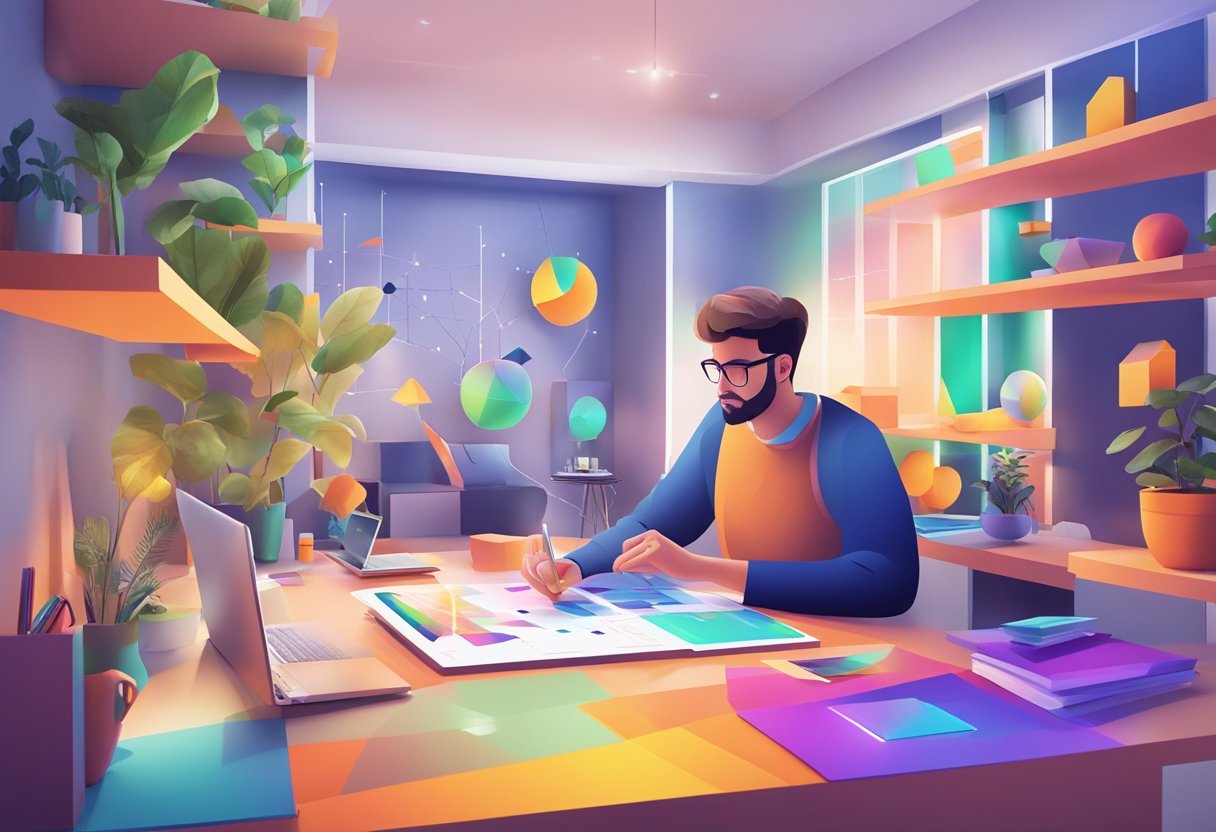Augmented reality (AR) is a technology that has been around for a while, but it is only in recent years that it has become more accessible to the general public. AR is the integration of digital information with the real world, creating an immersive experience that can be used for entertainment, education, and business purposes. AR has the potential to change the way we interact with the world around us, and it is an exciting field to get into for those who are interested in technology and immersive experiences. In this blog post, I will share with you how to get into augmented reality to start a career in AR.
Understanding Augmented Reality is the first step towards getting into AR development. AR-enabled devices, such as smartphones or tablets, utilize the built-in camera, GPS, and sensors to detect the user’s position, orientation, and the surrounding environment. AR developers must be able to work with video game engines such as Unity or Unreal, which allow them to recreate environments in 3D. Besides, AR developers must be able to understand programming languages such as C++, C#, JavaScript, or Swift. Design and interaction in AR is also an important consideration, as the user interface and experience must be intuitive and easy to use.
Basics of Augmented Reality
Augmented Reality (AR) refers to a technology that superimposes digital information onto the physical world, creating an interactive and immersive experience. AR is typically experienced through a mobile device or headset, which overlays digital content onto the real world. This technology has the potential to transform various industries, including education, healthcare, business, entertainment, and marketing.
AR works by using sensors, cameras, and other technologies to detect the user’s environment and overlay digital content onto it. This creates a seamless integration between the digital and physical worlds, allowing users to interact with digital content in real-time.
AR vs. VR: Differences and Similarities
AR and Virtual Reality (VR) are often compared, but they are fundamentally different technologies. While AR overlays digital content onto the real world, VR creates a completely immersive digital environment that users can interact with. AR and VR share some similarities, such as their ability to create immersive experiences. However, AR has a more practical application in various industries, while VR is primarily used for entertainment purposes.
The Impact of AR on Various Industries
AR has the potential to revolutionize various industries, including education, healthcare, business, entertainment, and marketing. In education, AR can be used to create interactive and immersive learning experiences that engage students and enhance their understanding of complex concepts.
In healthcare, AR can be used to provide doctors with real-time information about patients, improving diagnosis and treatment. In business, AR can be used to create interactive product demonstrations and improve customer engagement. In entertainment, AR can be used to create immersive gaming experiences that blur the line between the digital and physical worlds. AR has the potential to transform the way we interact with digital content and the physical world, creating new and exciting possibilities for various industries.
Becoming Augmented Reality Developer

Skills required to become an augmented reality developer:
- Proficiency in programming languages (e.g., C#, C++, Java, Swift)
- Understanding of AR development platforms (e.g., ARKit, ARCore, Vuforia)
- Experience with 3D modeling and animation
- Familiarity with game engines (e.g., Unity, Unreal Engine)
- Knowledge of computer vision and image processing
- Strong grasp of mathematics, especially linear algebra and geometry
- UI/UX design skills for creating intuitive user experiences
- Problem-solving and critical thinking abilities
- Ability to work with cross-functional teams
- Continuous learning mindset to keep up with evolving AR technologies
- Experience with mobile platform development (iOS, Android)
- Knowledge of version control systems, such as Git
How to become an augmented reality developer
- Acquire Basic Programming Skills: Learn programming languages relevant to AR development, such as C# for Unity or Java for Android.
- Study AR Development Platforms: Get familiar with AR development kits like ARKit for iOS and ARCore for Android. Explore their documentation and tutorials.
- Learn 3D Modeling: Gain skills in 3D modeling software (e.g., Blender, Maya) to create and animate objects for AR environments.
- Understand Game Engines: Master a game engine, preferably Unity or Unreal Engine, as they are widely used for AR development.
- Explore Computer Vision: Delve into computer vision to understand how AR apps interact with the real world.
- Develop UI/UX Design Skills: Design user interfaces and experiences that are intuitive and enhance the AR experience.
- Build a Portfolio: Create AR projects to demonstrate your skills. This could include simple AR apps, interactive games, or visualizations.
- Engage with the AR Community: Join online forums, attend workshops, and participate in hackathons to learn from others and stay updated on the latest trends.
- Gain Mobile Development Experience: Since many AR apps are mobile-based, experience with iOS or Android development is crucial.
- Learn Version Control: Use tools like Git for source code management to collaborate with teams and manage changes to project files.
- Apply for AR Development Roles: Look for job openings that match your skill set, and apply for positions as an AR developer.
- Keep Learning and Adapting: Stay informed about the latest advancements in AR technology and continuously improve your skills.
Getting Started with AR Development

Augmented Reality (AR) is a rapidly growing field that has been used in various industries, including gaming, education, and marketing. As a developer, getting started with AR development can be an exciting and rewarding experience. This section provides an overview of the essential steps to get started with AR development.
Choosing the Right Programming Language
To develop AR applications, developers need to have a solid understanding of programming languages such as C++, Java, C#, and Unity. C++ is a popular programming language used in AR development, while Java is commonly used in Android-based AR applications. C# is used in Unity, one of the most popular game engines for AR development. Developers can also use Unreal Engine, which supports C++ and Blueprint Visual Scripting.
Essential AR Development Tools
Developers need to have the right tools to build AR applications. AR development tools include AR software development kits (SDKs), AR frameworks, and AR libraries. The most popular AR SDKs include ARCore for Android and ARKit for iOS. These SDKs provide developers with the necessary tools to build AR applications for mobile devices. AR frameworks, such as Vuforia and Wikitude, provide developers with the ability to create AR applications for multiple platforms.
Setting Up Your Development Environment
To start developing AR applications, developers need to set up their development environment. This involves installing the necessary software and tools, including an integrated development environment (IDE) such as Visual Studio or Eclipse. Developers also need to install the necessary AR SDKs, frameworks, and libraries. The development environment should be configured to support the programming language used for AR development.
Getting started with AR development requires a solid understanding of programming languages, essential AR development tools, and setting up the development environment. With the right tools and knowledge, developers can create exciting and innovative AR applications for various industries.
Design and Interaction in AR

Augmented Reality (AR) design and interaction can be challenging, but it is essential to create an immersive and engaging experience for users. In this section, we will explore the design principles, creating interactive AR content, and user experience and engagement.
Design Principles for AR
Designing for AR requires a different approach than traditional design. The designer needs to consider the physical environment where the AR content will be displayed. It is also essential to create a seamless integration between the digital and physical worlds.
To design an AR experience, the designer needs to understand the user’s needs and the context in which the AR content will be used. They should also consider the device’s capabilities, such as the camera, sensors, and display.
Creating Interactive AR Content
Creating interactive AR content involves designing 3D objects that can be placed in the real world. The designer needs to consider the object’s size, orientation, and placement to ensure that it looks natural in the real world.
AR apps can be used to create interactive AR content. These apps provide tools to create 3D objects, animations, and interactions. The designer can also use a smartphone or tablet to preview the AR content before deploying it.
User Experience and Engagement
AR can enhance user experience and engagement by providing an immersive and interactive experience. The designer needs to create a user-friendly interface that is easy to navigate and understand. The designer should also consider the user’s behavior and interaction with the AR content. They should ensure that the AR content is responsive and provides feedback to the user’s actions.
Designing for AR requires a different approach than traditional design. The designer needs to consider the physical environment, device capabilities, and user behavior. They should also create interactive AR content that provides an immersive and engaging experience for the user.
Hardware and Software Considerations

Choosing the Right AR Hardware
When it comes to AR hardware, there are a variety of options available in the market. The choice of hardware depends on the intended use case and the user’s budget. AR-enabled smartphones and tablets are the most common AR devices used by consumers. These devices have built-in cameras, GPS, and sensors that detect the user’s position, orientation, and the surrounding environment. They are also lightweight and portable, making them ideal for mobile AR experiences.
For more advanced AR experiences, AR glasses are a great option. AR glasses, such as the Microsoft HoloLens and the Oculus Rift, allow for hands-free AR experiences. They are equipped with powerful processors, high-resolution displays, and advanced sensors that provide a more immersive AR experience. Smart glasses, such as Google Glass, are also a good option for lightweight, hands-free AR experiences.
Software Requirements for AR
To create AR experiences, developers need to have the right software tools. There are a variety of software tools available for AR development, including ARCore for Android devices, ARKit for iOS devices, and Unity for cross-platform AR development.
ARCore is Google’s AR platform for Android devices. It allows developers to create AR experiences that are optimized for Android devices. ARKit is Apple’s AR platform for iOS devices. It provides developers with tools to create AR experiences that are optimized for iOS devices. Unity is a cross-platform game engine that supports AR development. It allows developers to create AR experiences that work on multiple platforms.
In addition to the AR development tools, developers also need to consider the hardware requirements for AR development. AR development requires a powerful computer with a dedicated graphics card and at least 8GB of RAM. Developers also need to have a device with a camera, such as a smartphone or tablet, to test their AR experiences.
Choosing the right hardware and software tools is crucial for creating successful AR experiences. Developers need to consider the intended use case, budget, and hardware requirements when selecting AR hardware and software tools.
Building a Career in Augmented Reality
Augmented Reality (AR) is a rapidly growing field that offers a range of career opportunities for professionals interested in the intersection of technology and creativity. The following subsections outline some of the key educational pathways, professional roles, and portfolio-building strategies that can help aspiring AR developers build a successful career in this field.
Educational Pathways
There are several educational pathways that can help aspiring AR developers gain the skills and knowledge needed to succeed in this field. These pathways include traditional computer science and software engineering degrees, as well as more specialized AR and VR development programs offered by universities and online learning platforms like Udemy.
In addition to formal education, aspiring AR developers can also gain valuable experience by participating in hackathons, attending industry conferences, and contributing to open-source AR development projects.
AR Development as a Profession
AR development is a profession that requires a combination of technical skills, creative vision, and project management expertise. AR developers may work for a range of organizations, including software development companies, gaming studios, and advertising agencies.
AR developers may specialize in specific AR development platforms, such as ARKit, Unity, or Unreal Engine, or in specific areas of AR development, such as 3D modeling and animation or UX design. Successful AR developers are able to work collaboratively with designers, engineers, and other stakeholders to create engaging and innovative AR experiences.
Finding Work and Building a Portfolio
Building a strong portfolio is essential for aspiring AR developers looking to break into the field. A strong portfolio should showcase a range of AR development projects, including both personal and professional work.
To find work in the AR development field, aspiring developers can leverage online job boards, networking events, and social media platforms to connect with potential employers and colleagues. It is also important to stay up-to-date with the latest trends and developments in the AR development field, and to continually refine and develop one’s skills and knowledge to stay competitive in this rapidly evolving industry.
Frequently Asked Questions

What educational background is needed to pursue a career in augmented reality?
To pursue a career in augmented reality, a degree in computer science, engineering, or a related field is recommended. However, it is not mandatory to have a degree in these fields to work in augmented reality. Having a strong portfolio of work and experience with relevant tools and technologies can also be valuable.
What are the potential career paths in the augmented reality industry?
The augmented reality industry offers a wide range of career paths, including software development, hardware engineering, user experience design, and project management. Other potential roles include 3D modeling and animation, data analytics, and quality assurance.
What is the average salary for professionals in the augmented reality field?
The salary for professionals in the augmented reality field varies depending on the specific job title, location, and level of experience. In general, however, salaries in the augmented reality industry tend to be competitive and higher than average.
What resources are recommended for beginners to learn about augmented reality?
There are many resources available for beginners to learn about augmented reality, including online courses, tutorials, and books. Some popular resources include Coursera’s Introduction to Augmented Reality and ARCore course, Unity’s AR Foundation tutorials, and the book “Augmented Reality for Developers” by Jonathan Linowes.
How challenging is it for newcomers to acquire skills in augmented reality?
Acquiring skills in augmented reality can be challenging, as it requires knowledge of multiple disciplines, including computer science, engineering, and design. However, with the right resources and dedication, it is possible to learn and develop skills in augmented reality.
What roles are available for designers within the augmented reality sector?
Designers play a crucial role in the augmented reality sector, as they are responsible for creating the user experience and interface. Potential roles for designers in the augmented reality sector include user experience (UX) design, user interface (UI) design, and 3D modeling and animation.




